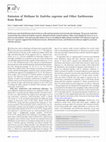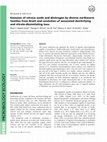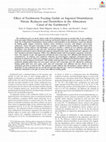Papers by Peter Depkat-Jakob

Applied and Environmental Microbiology, Apr 15, 2012
Earthworms emit denitrification-derived nitrous oxide and fermentation-derived molecular hydrogen... more Earthworms emit denitrification-derived nitrous oxide and fermentation-derived molecular hydrogen. The present study demonstrated that the earthworm Eudrilus eugeniae, obtained in Brazil, emitted methane. Other worms displayed a lesser or no capacity to emit methane. Gene and transcript analyses of mcrA (encoding the alpha subunit of methyl-CoM reductase) in gut contents of E. eugeniae suggested that Methanosarcinaceae, Methanobacteriaceae, and Methanomicrobiaceae might be associated with this emission. E arthworms can be a dominant soil fauna and can greatly influence the structure and fertility of soils (1, 3, 7). The high microbial diversity in the gut of the earthworm largely reflects the high microbial diversity of the ingested soil (i.e., ingested substrate) (6, 8, 21). The low availability of molecular oxygen (O 2) and high availability of saccharides in the gut of the earthworm can stimulate ingested microbes capable of anaerobiosis (6, 13, 14, 32, 33). This stimulation leads to the emission of denitrificationderived nitrous oxide and fermentation-derived molecular hydrogen (H 2) during gut passage (15, 20, 25, 27, 32, 33). Previous studies have failed to detect the emission of methane from earthworms, and the methanogenic capacities of gut contents and feces of earthworms appear to be insignificant (6, 16, 19, 30). However, those studies were restricted to a limited number of earthworm species. The objective of the present study was to evaluate the capacity of native and nonnative earthworms in Brazil to emit methane and to assess the potential occurrence of methanogens in gut contents by gene and transcript analyses of mcrA and mrtA (encoding the alpha subunit of methyl-CoM reductase and its isoenzyme, respectively). Field sites, earthworms, and earthworm substrates. The seven different earthworm substrates are outlined in Table 1. In March 2011, Amynthas gracilis (Megascolecidae; not native to Brazil [18]) was collected from the organic layer and upper 5 cm of and Pontoscolex corethrurus (Glossoscolecidae; native to Brazil [18]) from a 5-to 30-cm depth of grassland soil within the Esalq campus in Piracicaba, state of São Paulo, Brazil (22°42=22ЉS, 47°38=02ЉW), along with their grassland soil (substrate 4). Glossoscolex paulistus (Glossoscolecidae; native to Brazil [18]) was collected from a pasture near the district of Assistência, Rio Claro, state of São Paulo, Brazil (22°30=47ЉS, 47°36=55ЉW), along with its soil (substrate 5), and Glossoscolex sp. (Glossoscolecidae) was collected from a neighboring swampy meadow (22°30=36ЉS, 47°36=41ЉW), along with its soil (substrate 6). In addition, Rhinodrilus alatus (Glossoscolecidae; native to Brazil [18], collected near Paraopeba, state of Minas Gerais, Brazil) was obtained from local distributors in the district of Assistência along with its soil (substrate 7). Eudrilus eugeniae (Eudrilidae; not native to Brazil [18]) and Perionyx excavatus (Megacsolecidae) were obtained from the earthworm distributor Minhobox along with their substrate (substrate 1), which was commercially composted cow manure. The composting process involves the periodic wetting and daily turn
Methanogens associated with the in vivo emission of CH 4 by E. eugeniae .

FEMS Microbiology Ecology, 2012
The anoxic earthworm gut augments the activity of ingested microorganisms capable of anaerobiosis... more The anoxic earthworm gut augments the activity of ingested microorganisms capable of anaerobiosis. Small earthworms (Lumbricidae) emit denitrificationderived N 2 O, whereas the large Octochaetus multiporus (Megascolecidae) does not. To examine this paradox, differently sized species of the families Glossoscolecidae (Rhinodrilus, Glossoscolex, Pontoscolex), Megascolecidae (Amynthas, Perionyx), Acanthodrilidae (Dichogaster), and Eudrilidae (Eudrilus) from Brazil were analyzed. Small species and the large Rhinodrilus alatus emitted N 2 O, whereas the large Glossoscolex paulistus did not, even though its gut could denitrify. N 2 and N 2 O were emitted concomitantly, and R. alatus emitted the highest amount of N 2. Denitrifiers and dissimilatory nitrate reducers were analyzed by barcoded amplicon pyrosequencing of narG, nirK, and nosZ. Gene sequences in gut and soil of the large G. paulistus were similar, whereas sequences in gut and soil of the small Amynthas gracilis were different and were also different compared with those of the gut and soil of G. paulistus. However, the denitrifying gut microbiota for both earthworms appeared to be soil-derived and dominated by Rhizobiales. The results demonstrated that (1) the emission of denitrification-derived N 2 O is widespread in different earthworm families, (2) large earthworms can also emit nitrogenous gases, and (3) ingested members of Rhizobiales are associated with this emission.

Applied and Environmental Microbiology, 2010
The earthworm gut is an anoxic nitrous oxide (N 2 O)-emitting microzone in aerated soils. In situ... more The earthworm gut is an anoxic nitrous oxide (N 2 O)-emitting microzone in aerated soils. In situ conditions of the gut might stimulate ingested nitrate-reducing soil bacteria linked to this emission. The objective of this study was to determine if dissimilatory nitrate reducers and denitrifiers in the alimentary canal were affected by feeding guilds (epigeic [ Lumbricus rubellus ], anecic [ Lumbricus terrestris ], and endogeic [ Aporrectodea caliginosa ]). Genes and gene transcripts of narG (encodes a subunit of nitrate reductase and targets both dissimilatory nitrate reducers and denitrifiers) and nosZ (encodes a subunit of N 2 O reductase and targets denitrifiers) were detected in guts and soils. Gut-derived sequences were similar to those of cultured and uncultured soil bacteria and to soil-derived sequences obtained in this study. Gut-derived narG sequences and narG terminal restriction fragments (TRFs) were affiliated mainly with Gram-positive organisms ( Actinobacteria ). The...
Applied and Environmental Microbiology, 2012
Earthworms emit denitrification-derived nitrous oxide and fermentation-derived molecular hydrogen... more Earthworms emit denitrification-derived nitrous oxide and fermentation-derived molecular hydrogen. The present study demonstrated that the earthworm Eudrilus eugeniae , obtained in Brazil, emitted methane. Other worms displayed a lesser or no capacity to emit methane. Gene and transcript analyses of mcrA (encoding the alpha subunit of methyl-CoM reductase) in gut contents of E. eugeniae suggested that Methanosarcinaceae , Methanobacteriaceae , and Methanomicrobiaceae might be associated with this emission.
Methanogens associated with the in vivo emission of CH 4 by E. eugeniae .

Uploads
Papers by Peter Depkat-Jakob